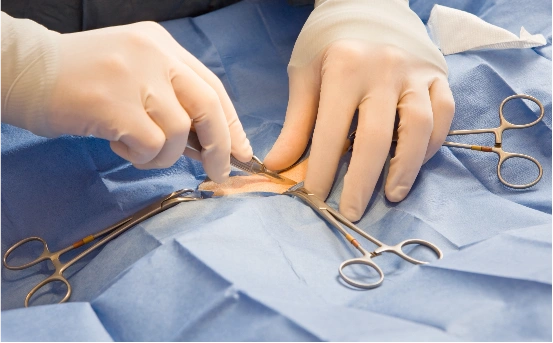Treatment indicating bladder outlet incision surgery can significantly impact the quality of life, especially in men with conditions like benign prostatic hyperplasia (BPH) or urethral stricture. When medications fail to provide relief, surgical options like Bladder Outlet Incision Surgery (BOIS) become necessary.
While medications like alpha-blockers or 5-alpha-reductase inhibitors are often the first line of treatment, they are not always effective for all patients. In cases where medical therapy does not provide sufficient relief, surgical intervention becomes necessary. One of the most effective and minimally invasive procedures used to treat bladder outlet obstruction is Bladder Outlet Incision Surgery (BOIS).
What is Bladder Outlet Obstruction?
Bladder outlet obstruction refers to any blockage at the base or neck of the bladder that reduces or stops the flow of urine into the urethra. This condition can lead to :-
-
Difficulty in urination
-
Weak urinary stream
-
Frequent urination
-
Incomplete bladder emptying
-
Urinary retention
Common causes include :-
-
Benign Prostatic Hyperplasia (BPH)
-
Urethral strictures
-
Bladder neck contracture
-
Congenital narrowing (especially in younger males)
-
Post-surgical scar tissue
What is Bladder Outlet Incision Surgery?
Bladder Outlet Incision Surgery, also known as Bladder Neck Incision (BNI) or Transurethral Incision of the Prostate (TUIP), is a minimally invasive urological procedure. It involves making small incisions in the bladder neck or prostate to relieve urinary obstruction and improve urine flow.
The procedure is typically performed endoscopically, meaning no external incisions are made. It is ideal for patients with mild to moderate obstruction or a smaller prostate size (less than 30 grams).
Treatment indicating bladder outlet incision surgery
Doctors recommend this surgery only when non-surgical methods fail or if the bladder outlet obstruction severely impacts urinary function. Common indications include :-
- Benign Prostatic Hyperplasia (BPH) :- Patients with BPH who experience significant urinary symptoms and do not respond well to alpha-blockers or 5-alpha-reductase inhibitors may benefit from TUIP/BNI.
- Bladder Neck Contracture :- A narrowing of the bladder neck due to previous prostate surgery or radiation therapy can be managed effectively with a bladder neck incision.
- Primary Bladder Neck Obstruction (PBNO) :- A rare condition where the bladder neck fails to open properly during urination. BOIS can help relieve this functional obstruction.
- Congenital Narrowing in Young Males :- Young men with a congenital narrowing at the bladder neck who present with weak stream or straining to void may require this procedure.
- Failed Medical Management :- If medications like alpha-blockers and other non-invasive treatments fail to relieve symptoms after 6-12 months, surgical intervention may be indicated.
- Recurrent Urinary Tract Infections :- Chronic UTIs resulting from poor bladder emptying due to obstruction can be an indication for surgical correction.
- Post-TURP Scar Tissue :- Sometimes patients who undergo Transurethral Resection of the Prostate (TURP) may develop scar tissue that causes obstruction, which can be treated with BOIS.
Diagnostic Tests Before BOIS
Before recommending bladder outlet incision surgery, a urologist typically performs the following diagnostic assessments :-
-
Uroflowmetry :- to evaluate urine flow rate.
-
Post-void residual (PVR) measurement :- to determine the amount of urine left in the bladder after voiding.
-
Cystoscopy :- to visually inspect the bladder neck and urethra.
-
Urodynamic testing :- to assess how well the bladder and urethra are storing and releasing urine.
-
Ultrasound of the kidneys and bladder :- to check for signs of damage or urinary retention.
The Surgical Procedure: What to Expect?
Bladder Outlet Incision Surgery is typically done under general or spinal anesthesia and takes around 30 to 60 minutes. Here’s a step-by-step overview :-
-
Cystoscope Insertion :- A thin tube with a camera (cystoscope) is inserted into the urethra to visualize the bladder neck.
-
Incision :- Using a laser or electrocautery instrument, one or two small incisions are made at the 5 or 7 o’clock position of the bladder neck.
-
Widening of the Outlet :- These cuts relieve the obstruction by widening the bladder neck and allowing free urine flow.
-
Catheterization :- A Foley catheter is placed temporarily to aid urine drainage post-surgery.
Benefits of Bladder Outlet Incision Surgery
Patients undergoing BOIS often report significant improvement in urinary symptoms and quality of life. Key benefits include :-
-
Improved urine flow
-
Reduced frequency and urgency
-
Decreased nighttime urination (nocturia)
-
Relief from urinary retention
-
Less dependence on medications
This procedure is also less invasive than a full TURP surgery, has quicker recovery, and preserves ejaculation in many cases, especially in TUIP for younger men.
Risks and Possible Complications
While BOIS is generally safe, like any surgical procedure, it may have some risks, including :-
-
Temporary blood in urine
-
Urinary tract infections
-
Incontinence (rare)
-
Retrograde ejaculation (especially in BPH patients)
-
Bladder neck re-stenosis (recurrence of narrowing)
-
Need for repeat surgery in some cases
Most of these risks are short-term and manageable with proper post-operative care.
Post-Surgery Recovery and Aftercare
Hospital Stay
Patients may stay in the hospital for a day or less. The Foley catheter is usually removed within 24 to 48 hours.
Recovery Timeline
-
Initial discomfort :- Mild burning during urination for a few days.
-
Activity :- Avoid strenuous activities for 1–2 weeks.
-
Hydration :- Drink plenty of water to flush the urinary tract.
-
Medication :- Pain relief and antibiotics may be prescribed.
Most patients return to normal routines within 7 to 10 days, and full improvement in urinary symptoms is seen in 4 to 6 weeks.
When to Consult a Urologist?
You should consult a urologist if you experience :-
-
Difficulty starting urination
-
Weak or interrupted urine stream
-
Frequent urination or urgency
-
Painful urination or urinary retention
-
Recurring urinary infections
Early diagnosis and timely intervention can help avoid complications like bladder damage or kidney dysfunction.
Conclusion
Bladder Outlet Incision Surgery is a highly effective, minimally invasive treatment for relieving urinary obstruction caused by bladder neck contracture, BPH, or primary bladder neck obstruction. It offers a faster recovery, fewer complications, and significant symptom relief, especially when medications fail to help.























